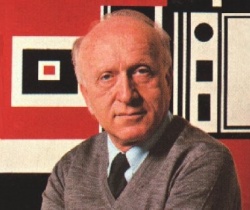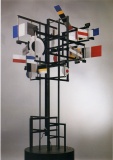Nicolas Schöffer
 | |
| Born |
September 6, 1912 Kalocsa, Hungary |
|---|---|
| Died |
January 8, 1992 (aged 79) Paris, France |
Nicolas Schöffer (Schöffer Miklós) was a Hungarian-born French artist, considered the father of cybernetic art. He was born in Kalocsa, Hungary and resided in Paris from 1936 till his death in his Montmartre atelier, Villa des Arts. His career touched on painting, kinetic sculpture, architecture, urbanism, film, TV, and music. Indeed he collaborated on music with Pierre Henry. All of the artistic actions of Schöffer were done in the pursuit of a dynamism in art.
This interest in artistic dynamism was originally initiated by the Cubo-Futurists and then intensified and solidified by the Constructivist artists, such as Naum Gabo, Anton Pevsner, Laszlo Moholy-Nagy and Ludwig Hirschfeld-Mack, who were concerned with opening up the static three-dimensional sculptural form to a fourth dimension of time and motion. And this was the intention of Schöffer as well. In 1948 he started to employ spatial dynamics in his work, later in 1957 the light dynamics (by integrating light, music, film), and since 1959 the element of time resulting in the kinetic works.
Schöffer however, coming well after, benefited from cybernetic theories (theories of feedback systems primarily based on the ideas of Norbert Wiener) in that they suggested to him artistic processes in terms of the organization of the system manifesting it (e.g., the circular causality of feedback-loops). For Schöffer, this enabled cybernetics to elucidate complex artistic relationships from within the work itself.
His CYSP 1 (1956) is considered the first cybernetic sculpture in art history in that it made use of electronic computations as developed by the Philips Company. The sculpture is set on a base mounted on four rollers, which contains the mechanism and the electronic brain. The plates are operated by small motors located under their axis. Photo-electric cells and a microphone built into the sculpture catch all the variations in the fields of color, light intensity and sound intensity. All these changes occasion reactions on the part of the sculpture.
Consequently his kinetic sculptural compositions were able to parallel the work of Warren McCulloch and his adaptation of cybernetics in formulating a creative epistemology concerned with the self-communication within an observer's psyche and between the psyche and the surrounding environment. This is the primary usefulness of cybernetics in studying the supposed subject/object polarity in terms of artistic experience.
Works
Bibliography
- Frank Popper, From Technological to Virtual Art, Leonardo Books, MIT Press, 2007
- Julia M. Busch, A Decade of Sculpture: the New Media in the 1960s, The Art Alliance Press: Philadelphia; Associated University Presses: London, 1974. ISBN 0879820071
External links
- Nicolas Schöffer's website at OLATS put together by the Schöffer family
- Nicolas Schöffer at compArt daDA
- Nicolas Schöffer's Précurseur de l’art cybernétique exhibition, 2005
- Images of his studio
- Review of his 2005 exhibition by Joseph Nechvatal
- Sound recordings from Schöffer's spatiodynamic scultpures
- Nicolas Schöffer at French Wikipedia
- Nicolas Schöffer at English Wikipedia

